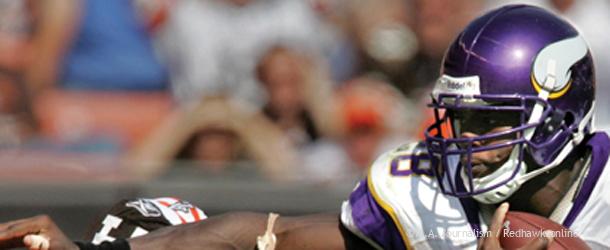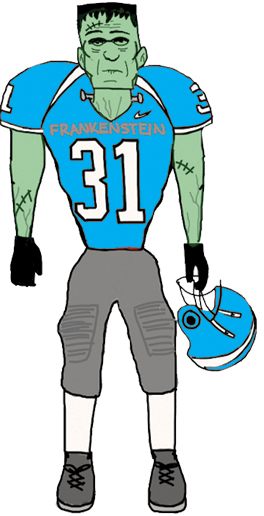Recent scandals in the NFL come from long lasting issues with punishment
The Everyday Heroes of the American population are sports players. From gymnastics to rugby, children to adults idolize those of us capable of astonishing physical feats. But what happens when that power we so liberally give to our heroes is abused?
When word of Adrian Peterson hitting his child and the video of Ray Rice beating his wife hit the news, the American population was shocked, horrified and nonplussed to see the violence in some of the men that they had raised above themselves and allowed their children to hang posters of in their room.
But is the violence, though disturbing, really that surprising? Since high school, most of the athletes that run America today have gotten free passes from fights, drugs and other felonies. In college, according to recent reports, many are getting away with rape and other sexual assaults. And now in the NFL they’re beating up women and children.
America loves sports stars. And the heads of schools and major organizations (like Roger Goodell) know that. They know that the better players they can turn out, the more money they can make and the more attention their respective school/organization can garner.
And because of that, repercussions have been minimal and consequences are often waved off as unnecessary or damaging to the greater good.
Media has been a key tool in fighting this kind of outrageous attitude. Through insightful journalism and illuminating reports, and even with the help of gossip sites like TMZ, the back door dealing of the athletic world are being exposed.
For example, new information reported to the Associated Press from a law enforcement official claims that the video of Ray Rice abusing his girlfriend was actually sent to the NFL headquarters to the attention of the league security chief Jeffrey Miller in April.
If that is true, then the NFL had access to the Rice video for months. Before Goodell gave him the minimal punishment of a two game suspension.
Goodell now claims in a recent letter to NFL team owners, “I didn’t get it right. Simply put, we have to do better. And we will.” This letter was sent after the public got a hold of the Ray Rice video and began to express extreme disgust with they way the NFL was being run.
So how does this cycle of violence and cover-ups begin, how does a child with innate talent morph into a monster?
The night of August 11, 2012 will always live in infamy in the little town of Steubenville, Ohio.
That night the jocular attitudes of the football players that ran the town exploded in a horrifying manner that ended with the rape of a female peer. The girl was incapacitated by alcohol at the time of her attack, and as the multiple boys forced themselves on her, they also documented the event with social media.
Although the digital trail was impossible to cover up, that doesn’t mean nobody tried. Following the violence, many in the small town community decided that protecting the football players from any repercussions was the most beneficial solution.
Thankfully, and inevitably, the truth did come out. In the wake of the overwhelming evidence, two of the football players, Ma’lik Richmond and Trent Mays, 16 years old at the time of the rape, were convicted in juvenile court.
And the IT Director at Steubenville City Schools,William Rhinaman, was indicted with tampering with evidence, obstruction of justice, obstruction of a public official and grand jury perjury, charges still being argued against in court.
And the coach of the football team, Reno Saccoccia, was accused of contributing to a cover up after texts entered into the boy’s trial evidence implied that he knew of the attack. And Steubenville City Schools superintendent Michael McVey was charged with obstructing justice, tampering with evidence, obstructing official business and falsification, and is still in an ongoing trial.
When the news of the Steubenville “Rape Crew” was publicized, the world reacted in shock. But behind the initial shock there was a grain of uncertainty. While it’s easy to point out the major flaws in hiding star athlete’s more horrific crimes, the Ohio case also illuminated an American high school sports culture that gives athletes special lee-way, not just at a criminal level but also in ways that hit closer to home with everyone.
For example; the star basketball player with the attitude problem. The arrogance and condescending attitude that would be considered repulsive in an average student, is accepted as normal with the athlete.
And thus begins the slippery slope, and some athletes that begin with this little bit of excused behavior continue on to beat their girlfriend’s in elevators and expect to get away with it. Just because they can play a game well.
High School cases like Steubenville are fairly rare, whether because of intensive coverups, or easier management of players, or a slightly less strong sense of entitlement. College athletes however, have a violent record that stretch for miles.
According to the Benedict/Crosset Study, an in-depth review of college violence across the nation, one in three college sexual assaults are committed by athletes, and “while male student-athletes comprise 3.3% of the population, they represent 19% of sexual assault perpetrators and 35% of domestic violence perpetrators.”
These stories are in the news all the time, along with the subsequent reveals of cover ups. In August, University of Missouri football coach Gary Pinkel that he knew about a 2008 rape allegation against former running back Derrick Washington, but didn’t ever punish him because police didn’t file charges.
This leniency allowed Washington to be accused by four more women of assault before he was dismissed from the football team in 2010, a consequence that only came after Washington was accused of felony deviant sexual assault, and put in prison.
Other stories from the past year include a story about Tulane football signee Niguel “Teddy” Veal, a 17 year old freshman who was booked on the charge of rape, charges that were dropped in August, allowing Veal to stay on the football team, according to Power Forward, a site that “looks at the impact of sports on culture and culture on sports.”
Again a culture of shying away from punishing those among the population with unique athletic abilities, and the ability to make the organizations they work for a lot of money, is revealed.
The Benedict/Crosset Study had this statistic: “The general population has a conviction rate of 80%. The conviction rate of an athlete is 38%.”
And then we arrive to the NFL and the current day scandals and crime sprees of influential athletes. Suddenly, the violence no longer seems so shocking. Each of these elite athletes has most likely experienced at one point or another some part of this lenient culture, and possibly reaped the benefits of it in terms of their behavior.
In just August and September four NFL athletes were arrested for domestic violence charges, and despite Goodell’s claims nothing radical seems to be changing in the NFL.
But how much can the NFL really change if the basis of it’s players remains in this culture where if you can kick a brown ball through a goal you can get away with murder? To stop the violence across the board of NFL teams, you have to attack the root of the problem. The problem that begins in high school with letting the star jock get away with being a jerk.


